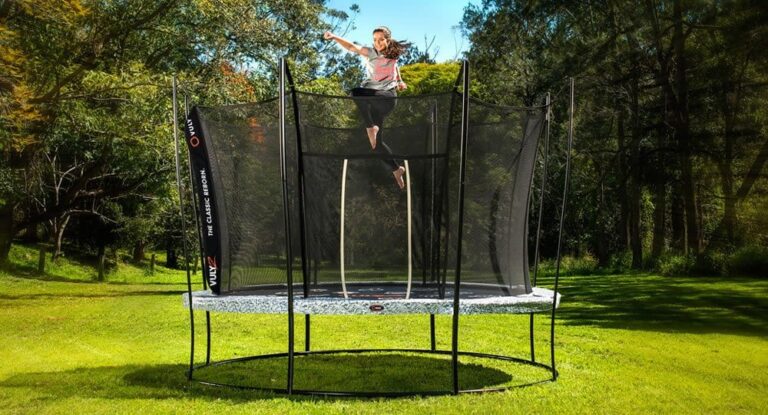Wouldn’t it be nice to get your heart rate up and start improving your fitness without the sore knees, hips, and feet that running can cause? Wouldn’t it also be nice to actually enjoy exercise, rather than feeling like a chore?
Trampolining is a great way to work the muscles and cardiovascular system without being hard on the joints. And trampoline exercises are a fantastic way to improve health, fitness, and well-being for everyone from the beginner to advanced, no matter your age.
Today we’re going to take you through some of our favorite trampoline exercises for general health and fitness. All you need is a trampoline or a rebounder and you’ll be ready to get started. Take a look at our list of the top-rated trampolines.
Lower Body Strength and Conditioning
Trampolining is lower-body dominant: these lower-body strength and conditioning exercises are a great example of how a beginner can use the instability of the trampoline to their advantage.
Whether you’re looking to improve your fitness, train the body for sports, or improve your performance in trampolining/gymnastics these exercises are a great choice:
#1. Single-Legged Bounces

Taking a hip-width stance, with the weight in the middle of your feet, bounce on one leg. Switch legs throughout to ensure that you’re training both legs evenly.
Single-legged bounces are only going to be helpful if you’re doing them right. Stabilising the knee and hip is the main challenge with this exercise. Be sure to keep the knee and ankle ‘soft’ to cushion your landing.
Note: avoid landing on a locked knee, as this can cause too much impact through the knee and hip joints. Ensure that your knee stays in line with your toes and does not “collapse” inwards – this increases injury risk and makes the exercise less effective.
Key Benefits
- Improve your balance: How often do you train moving on just one leg? Single-legged bounces develop balance and stability on a single leg, an under-developed skill in most people.
- Condition your ankles: Bouncing on one leg is a great way to start developing strength and resilience in the ankles, knees, and hips.
- Challenge yourself: One of the best reasons to perform the single-legged bounce is simply that it is more difficult. In exercise, more difficulty tends to translate to better results!
- Develop foundational strength: There are many skills in many sports that require the ability to balance on a single leg. Single-legged bouncing on a trampoline is a great way to train this skill for beginners.
What Muscles Does It Train?
The muscles and connective tissues of the legs are the main focus of the Single-Legged Bounce.
- Gluteus Maximus and Medius
- Quadriceps
- Gastrocnemius/Soleus
- Tibialis Anterior
Summary
This is one of the simplest skills you can perform on a trampoline, but it has profound benefits for anyone that wants to develop light footwork, strong ankles, and start to develop overall athletic balance. If you can’t balance and bounce on a single leg, you’re going to be unprepared for sports and athletics!
#2. Single Leg Squats

To perform this movement, stand on the trampoline on one foot. Keeping the knee in line with the toe and the back flat, lower your hips (back and down) as far as you can go without the knee collapsing or losing your balance. Keep the buttocks active and be sure to remain as stable and controlled as possible.
Note: when performing a single-leg squat, avoid rolling the weight into the front of your foot. You should also be sure to avoid the knee collapsing inwards. Be sure to keep the back as flat as possible – you can put your hands out in front of you to maintain your balance throughout the exercise.
Key Benefits
Once you’ve developed the necessary balance and strength through Single-Legged Bounces and Squats, single leg Squats are the next step in developing balance, stability and strength.
- Boost strength and power: Single-legged squats are a great way to develop strength and power.
- Develop stability and balance: Especially when performed on a trampoline, single-leg Squats are a great way to develop control over the knee – a key part of sports performance and injury prevention.
- Improve longevity and healthy aging: Improving single-leg balance and strength is a great way to maintain strength, mobility, and independence as you age.
What Muscles Does It Train?
The single leg Squat trains similar muscles to both the single-leg bounce and the squat. Obviously, this movement is all about the lower body, but using a single leg challenges the core to balance the body.
- Obliques
- Transversus Abdominus
- Rectus Abdominus
- Gluteus Maximus and Medius
- Quadriceps
- Gastrocnemius/Soleus
- Tibialis Anterior
Summary
Single-leg Squats are a great way to improve leg strength and stability through the lower body. The most important benefit is stabilizing and controlling the knee and hip during a single-legged knee bend. This is a great way to develop leg and hip strength, whilst reducing the tendency to “cave in” at the knees.
#3. Single-Leg Hip Thrust

Take a firm stance on the trampoline, with your weight in the rear of your foot. Raise one leg until the top of the thigh is parallel with the floor. Keeping your back flat and your knee in line with the toes, push the bum back and bend forwards at the hips – as far as you can go. From this position, reverse the movement by hinging at the hips and push the knee “through”, squeezing with the buttocks to finish the thrust.
Note: be sure to keep a flat back throughout the movement and keep the weight centered through the heel of the foot: avoid rounding the back or falling into the toes. When lowering, focus on hinging the hips – this is a key movement that you need to learn for improved performance and health.
Key Benefits
Developing an effective pattern of hip hinging is a great way to develop overall fitness and performance. Single-Leg hip thrusts are a great way to develop this pattern and, in combination with single-legged bounces and squats, develop overall balance and control of the knee.
- Learn the hip hinge: Developing the ability to hinge at the hips is an essential part of improving sport performance but, more importantly, is necessary for proper spinal health. If you learn to hinge at the hips, rather than rounding the back, you’re likely to experience less lower back pain and debilitating injury as a result!
- Develop knee control: The hip thrust develops the glutes and hamstrings, big players in the posterior chain. These muscles are essential for balancing the demands on the knee and hip joint, and are key to staying healthy and developing explosive power.
- Improve control and stability: We’ve mentioned the benefits of single-leg movements for control already. However, the combination of unilateral training with a hip hinge and hip thrust is a great way to develop overall co-ordination and movement quality.
Summary
Developing your ability to perform the Single-leg hip thrust on a trampoline is a great way to develop all-round athletic ability and co-ordination. This exercise has many “moving parts” and the individual pieces of the movement are challenging.
Performing this movement on a trampoline is a great way to add balance and stability training to an already-difficult movement. The movement from knee bend to extension and thrust is a great way to challenge the different muscles surrounding the knee and hip. This exercise is more challenging than the single-leg squat, but provides a great choice for developing overall athleticism and fitness.
Core Strengthening Exercises
Olympic trampolinists and gymnasts need amazing core strength to perform advanced techniques, and you can develop the same amazing core strength with practice.
The following core strengthening exercises strengthen the muscles of the abdomen – a huge benefit whether you want to perform amazing feats of gymnastics, or just look great.
#1. Twists/Core Rotation

Take a firm stance on the trampoline, with your weight in the rear of your foot. Keeping the abs tight, and the hips neutral, rotate through the core as you bounce.
Note: avoid bending over during this movement, and try to focus on rotating using the muscles of the core in a controlled manner.
Key Benefits
Training the core for trampolining and gymnastics isn’t just about sit-ups and planks. The muscles of the core have many functions, and one of the most overlooked is rotation.
- Improve your mobility: rotating the spine is a key part of mobility – rotating the spine is a great way to develop thoracic spine mobility.
- Develop core strength and stability: Rotation is a key part of developing strength and stability in the core – especially when presented with dynamic movements.
- Boost power and performance: Rotation is one of the key factors in developing power for sports, and strong rotational muscles will contribute to improved power.
What Muscles Does It Train?
The focus of twisting movements is developing strength and stability through the muscles of the core, the main muscles used are:
- Obliques
- Transversus Abdominus
- Rectus Abdominus
Summary
The obvious benefit of this movement is developing a strong, tight core that can stabilise for gymnastic and trampolining movements. However, developing strength in rotation is a key skill for almost any sport, and contributes to performance in sports like throwing and sprinting.
#2. The Tuck Jump

The tuck jump involves performing a high jump, after which the chest remains high and the knees are brought to the chest, with the arms wrapped around the legs, before returning to a perfectly straight position.
When performing the tuck jump, focus on two simple areas. First, make sure that your jump is totally straight and as high as possible. Second, be sure to pull the knees up and squeeze your abs, whilst keeping the chest high. Try and time your tuck so that it is at the top of your jump.
Note: avoid reaching down with the chest, as this will take the weight off of the abs. This is a core exercise, so it is important to involve the abdominal muscles as much as possible. Avoid tucking too early, as this can throw you off balance.
Key Benefits
- Easy to learn, easy to perform: The tuck jump is one of the easiest exercises to perform, and doesn’t require any previous experience with trampolining or gymnastics. You can perform this exercise the first time you step on a trampoline!
- Strengthen your core: The tuck jump is exactly like a knee raise – but more fun! String a few of these together and you’ll definitely feel it in your abs.
- Develop key gymnastic skills: The tuck jump is a great place to start training towards many other trampolining and gymnastic movements, like the back tuck.
What Muscles Does It Train?
The main muscles used in the tuck jump are the core and hip flexors. As mentioned above, the tuck jump is basically a more-dynamic version of the common ‘knee raise’ exercise. These both train the core, and you can perform several tuck jumps in a row quite easily. The main muscles this will train are:
- Transversus Abdominus
- Rectus Abdominus
- Obliques
- Iliopsoas (Hip Flexors)
Summary
The tuck jump is a foundational movement in trampolining – if you can’t do a good tuck jump, you’ll struggle to develop more advanced skills like the back tuck. This is a great exercise for developing the core, and learning how to keep the legs close to the body during trampolining exercises.
#3. The Pike Jump

To perform the pike jump, jump high and straight on the trampoline, bring the legs up with the toes pointed forward, and reach forwards to touch your toes. This should put you in a triangle shape at the top of the jump, and really maximise the use of the core muscles.
Note: avoid reaching down to the legs too early in the jump – this will reduce the effectiveness of the movement and increase the chance of back injury. Bring the legs up first, then reach forwards – not down.
Key Benefits
The pike jump makes this list for a few reasons:
- Get started with something easy: the pike jump is a simple exercise that can be learned and mastered without too much experience – making it a great beginner core exercise
- Strengthen your core: An easy and effective way of developing core muscles, the pike jump works the core muscles and the hip flexors.
- Build foundational movement: The pike jump also reinforcing the leg and arm positions for both trampolining and gymnastics.
What Muscles Does It Train?
As mentioned above, the pike jump is a great way to train the core, this is because it uses many of the muscles of the core:
- straTransverse Abdominus
- Rectus Abdominus
- Obliques
- Iliopsoas (Hip Flexors)
- But also requires good positions through the lower body, recruiting the muscles of the leg:
- Quadriceps
- Gastrocnemius/Soleus
Summary
The pike jump is a great way to start training the core, as well as providing some benefits to the legs. It is also a great way to begin training the positions and shapes necessary for more advanced trampolining exercises.
#4. The Straddle Jump

To perform the straddle jump, perform a regular high jump on the trampoline. At the top of the movement, bring the legs up (like in the tuck) and apart. When the legs have reached the ‘high and wide’ position, with the toes pointed forwards, lean forward to touch the toes.
Note: be sure to keep your legs straight at the top of the movement. Avoid bending down to the feet, instead focusing on brining the legs up and out in front of your belly button. If you perform the straddle too early or late in the jump, you will lose balance, so timing is key!
Key Benefits
The Straddle Jump is the last of our “foundational” exercises for trampolining and gymnastics.
The straddle jump is more advanced than the tuck jump or pike jump, and performing it perfectly requires a lot of mobility.
The Straddle position is key for advanced trampolining and gymnastics, so this is a great way to become familiar with the position.
- Develop mobility: Practicing the straddle position will help you develop mobility in the hips, something that you probably struggle with if you drive a lot or work a desk job.
- Strengthen your hips: The straddle works some of the under-used muscles of the hips, improving strength and posture.
- Learn key positions: You can’t be a good gymnast or trampolinist if you can’t straddle. The straddle is an important calisthenic movement and this is a great way to learn/reinforce the position.
What Muscles Does It Train?
The Straddle Jump trains some muscles that don’t play a large role in the tuck or pike. The main muscles used in this movement are:
- Transverse Abdominus
- Rectus Abdominus
- Obliques
- Iliopsoas (Hip Flexors)
But the elevated, straddled leg position also trains:
- Gluteus Maximus/Medius
- Quadriceps (Especially the Vastus Lateralis)
- Gastrocnemius/Soleus
- Quadratus Lumborum
Summary
The straddle position is something you’ll need to develop for almost any bodyweight sport or training routine. The straddle jump is much easier than any other form of straddle, and is a great way to start strengthening the muscles, as well as developing mobility.
Power and Speed
The following exercises provide a great combination of speed and power training – they will provide great training to carryover to sports and high-performance training.
Perform these exercises as part of a high-intensity circuit and you’ll be puffing in no time. If you’re looking to burn calories, improve conditioning, and boost performance these are a great place to start.
#1. Footwork Drills

There isn’t much to say about this exercise: run on the spot on the trampoline, moving your feet as quickly as you can, while staying tight through the core. Try to keep your feet underneath your hips and focus on finding a good rhythm with your feet against the trampoline. Remaining light on the feet, focus on keeping the hips in the same place and spend as little time with your foot on the floor as possible. Keep the core tight, arms tight to the body, and pump the arms like you’re sprinting.
Key Benefits
Fast footwork drills on a trampoline are a great way to remain light on your feet, burn more calories, and develop strength and conditioning through the legs and hips.
- Get your heart rate up: These drills are a great way to develop speed, and can be performed at high intensity as a great cardiovascular endurance workout.
- Develop better footwork: Practicing fast feet on the trampoline and developing rhythmic foot movement is a great way to improve the conditioning for boxing, gymnastics, and general fitness.
What Muscles Does It Train?
- Gastrocnemius/Soleus
- Obliques
- Quadriceps
- Glutes
Summary
Footwork drills on a trampoline are great for developing strength and stability in the ankles. Ankle injuries are incredibly common in sports and life, but this exercise is a great way to protect yourself. Fast footwork is a great way to improve speed and agility for sports, but this exercise is very intense and makes for a great endurance workout – especially as part of a HIIT circuit.
#2. The Jump Squat

The jump squat is simple: perform rapid, low bounces alternating with squats. For the squat position, keep the feet underneath the hips, the knees in line with the toes, and the back flat. Put your arms in front of yourself for balance if necessary. Go as low as possible whilst keeping these key positions.
Note: don’t let the knees cave in, the back round, or the chest drop. The key to performing a jump squat well is keeping the buttocks active and stabilizing the feet “outwards” against the trampoline. Go as low as possible, but don’t lose your positions. Despite common misconceptions, the knees can pass the toes, and going low will not hurt your knees if you keep the knees controlled.
Key Benefits
Just like a regular jump squat (i.e. without a trampoline), the jump squat on a trampoline is a great exercise to begin training the muscles of the legs and hips.
- Condition your lower body: jump squats can condition the ankles, knees, and hips – essentials for developing fitness, but also a great way to develop the strength around the joint you’ll need for gymnastics, cheer, or trampolining.
- Boost cardiovascular health and endurance: the length of the movement and rapid changing of position boosts the overall cardiovascular demands, increasing endurance.
What Muscles Does It Train?
Jump squats on a trampoline will focus mainly on the muscles of the core and lower body:
- Rectus Abdominus
- Gluteus Maximus/Medius
- Quadriceps
- Gastrocnemius/Soleus
Summary
Jump squats are a great way to begin developing the necessary strength and resilience for more advanced techniques in bodyweight-based sports (gymnastics, cheer, trampolining, etc.). Conditioning of the lower body is important for athletic performance in general, so consider combining this type of conditioning with further resistance training for the best results.
#3. Jumping Knee-To-Chest

To perform this movement, jump from a hip-width stance, focusing on explosive power through the legs. At the top of the jump, focus on rapidly pulling your knees to your chest. As with other movements, use the core to ‘pull’ the knees up, and be sure to keep the chest high rather than reaching down.
Note: when performing the knee-to-chest, avoid reaching down, and focus on posture. This is an exercise to improve power, speed, and core strength. Perform the movement quickly, with a high jump, and ensure that the abs re doing the work.
Key Benefits
This is a great exercise for training core strength and overall power. Focus on jumping as high as possible and bringing the knees as high as possible. This develops lower body power, whilst requiring core strength.
- Develop lower-body power: Jumping is a great way to develop strength and power through the lower body – performing lots of jumping exercises improves power, explosive strength, and speed.
- Boost core strength: This exercise combines a vertical jump with a knee-to-chest. Similar to a tuck jump, this exercise develops strength in the abs and obliques.
- Improve conditioning and burn fat: long, powerful movements like the jumping knee-to-chest are a great way to improve anaerobic conditioning and use more calories.
What Muscles Does It Train?
- Rectus Abodminus
- Obliques
- Quadriceps (Especially the Vastus medialis obliiqus)
- Glutes
Summary
The knee-to-chest is a great way to develop power through the lower body – the kind that will contribute to improved fitness and performance. This translates to improvements in gymnastics, trampolining, and other sports.
Whew. That’s it for this post!
Trampoline exercises can be a great way to begin training for core strength, conditioning, and improved stability and balance.
These simple exercises are our favorite because they have benefits to beginners, and provide a great way to start developing the skills necessary for training in bodyweight sports.
If you’re looking to get fitter, lose weight, or start training towards sports, these trampolining exercises are an amazing choice.
And don’t forget: always follow the safety rules.
Enjoy!










